The AMD Radeon RX 5600 XT Review, Feat. Sapphire Pulse: A New Challenger For Mainstream Gaming
by Ryan Smith on January 21, 2020 9:01 AM ESTPower, Temperatures, & Noise
Last, but not least of course, is our look at power, temperatures, and noise levels. While a high performing card is good in its own right, an excellent card can deliver great performance while also keeping power consumption and the resulting noise levels in check.
| Radeon Video Card Voltages | |||||
| 5600 XT Max | 5700 Max | 5600 XT Idle | 5700 Idle | ||
| 0.977v | 1.025v | 0.775v | 0.775v | ||
Interestingly, even with the BIOS update and AMD’s voltage-frequency curve extension, the voltages being used by our Sapphire Radeon RX 5600 XT are quite tame. The card never goes higher than 0.977v, which is almost 0.05v lower than the Radeon RX 5700, itself already a good deal lower than the full-fat Navi 10-based Radeon RX 5700 XT. While third-tier cards like the RX 5600 XT are uncommon, when we do see them they are normally running higher voltage (leakier) parts, and this is what I was expecting for AMD’s new part.
No wonder AMD is talking up the power efficiency of the card; even with its restricted clockspeeds, not going above 1.0v helps to ensure that power efficiency doesn’t take a dive by paying a massive power penalty to access the last few MHz worth of headroom.
| Radeon Video Card Average Clockspeeds (Rounded to the Nearest 10MHz) |
||||
| Game | Sapphire 5600 XT (Perf) | 5600 XT | 5700 | |
| Max Boost Clock | 1760MHz | 1670MHz | 1750MHz | |
| Official Game Clock | 1615MHz | 1375MHz | 1625MHz | |
| Tomb Raider | 1700MHz | 1610MHz | 1680MHz | |
| F1 2019 | 1700MHz | 1610MHz | 1650MHz | |
| Assassin's Creed | 1700MHz | 1660MHz | 1700MHz | |
| Metro Exodus | 1700MHz | 1600MHz | 1640MHz | |
| Strange Brigade | 1740MHz | 1660MHz | 1660MHz | |
| Total War: TK | 1740MHz | 1660MHz | 1690MHz | |
| The Division 2 | 1700MHz | 1610MHz | 1630MHz | |
| Grand Theft Auto V | 1720MHz | 1640MHz | 1690MHz | |
| Forza Horizon 4 | 1730MHz | 1650MHz | 1700MHz | |
Shifting over to clockspeeds, things look very good for the RX 5600 XT. The card’s clockspeeds are remarkably consistent, and this comes down to the fact that the card is rarely ever entirely power-bound. Rather, the card is running out of room on the voltage-frequency curve, making it very easy to get close to its peak clockspeeds in the process. This goes hand-in-hand with the relatively low voltage, allowing the card to run rather efficiently and avoid heavier power throttling.
Unsurprisingly, the card is closer to its peak when running at AMD’s reference clockspeeds than it is the default factory overclocked mode. Still, the latter sees the card average clockspeeds higher than the RX 5700, underscoring how these factory overclocked cards are primed to hit high clockspeeds, and that it’s going to be the lack of memory bandwidth that ultimately keeps them chasing the RX 5700.

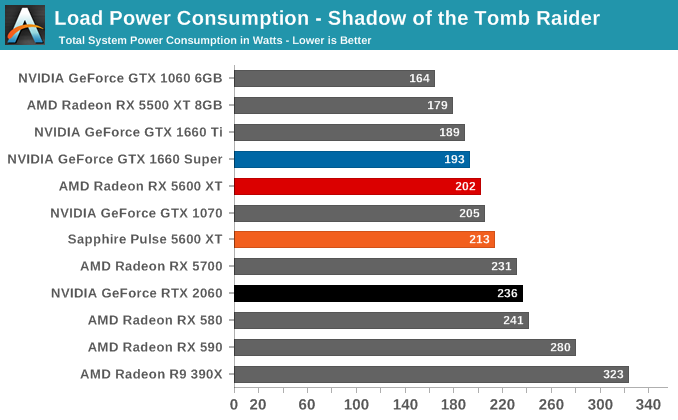
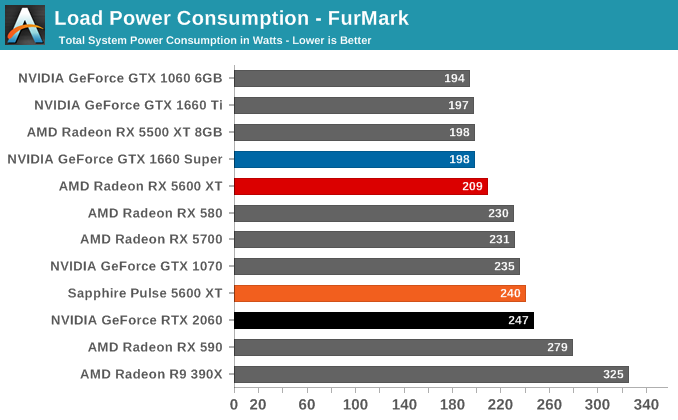
Taking a look at power consumption, we again find a good showing from Sapphire and AMD. The card’s idle power consumption shaves off a couple of watts at the wall relative to the RX 5700, thanks to the lower amount of VRAM and fully idled fans.
Meanwhile load power consumption also fares comparatively well. At reference clocks, we see AMD’s claims of higher power efficiency first-hand; measured at the wall, the card draws around 30W less than the RX 5700. Equally important, this keeps it relatively close to the GeForce GTX 1660 series. And while the RX 5600 XT ultimately ends up drawing more power, as we’ve seen it also handily outperforms those cards.
Sapphire factory overclock, however, is both a curse and a blessing. The blessing is that it improves the card’s performance to RTX 2060-levels, but the curse is that it does so while pushing power consumption to near RX 5700-levels. So when running at full tilt, the Pulse RX 5600 XT is less power efficient than the RX 5700, owing to its overall lower performance. Then again, it’s not like NVIDIA was doing very well to begin with. As a result, even when factory overclocked, the Pulse ends up drawing a bit less power than the nearest NVIDIA card.
I will also quickly note that the delta in power consumption between FurMark and Tomb Raider is higher for the RX 5600 XT than we’ve seen it in other Navi cards. All told, even at 1440p with the highest available settings, Tomb Raider is having a hard time keeping the RX 5600 XT busy enough that the card is running at maximum clockspeeds. This has made Tomb Raider turn into something of a best case scenario, as the card gets to idle a little bit.
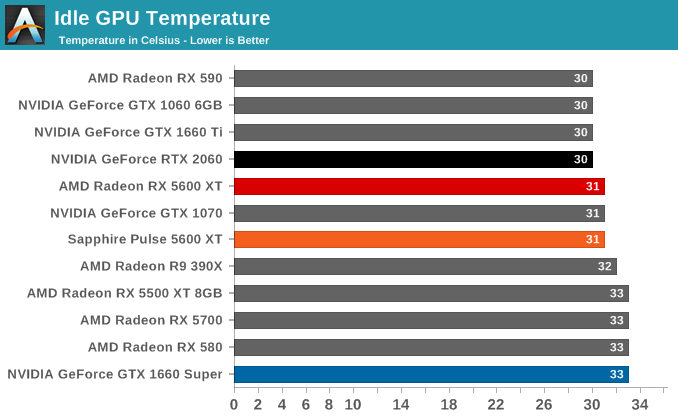
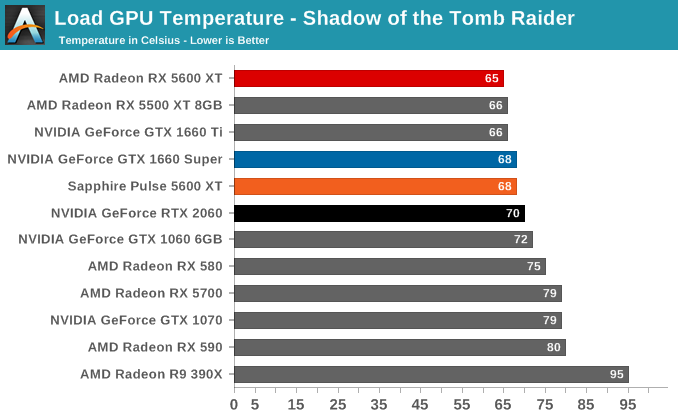

Moving on to temperatures, the large card has no problem cooling itself. In quiet mode the card never passes 68C, and even in full-on performance mode, the temperature maxes out at 74C. From a temperature perspective, Sapphire seems to have just about perfectly tuned the card’s cooler.
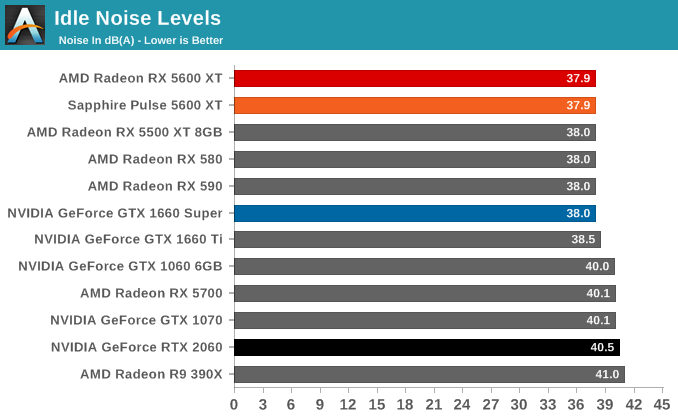
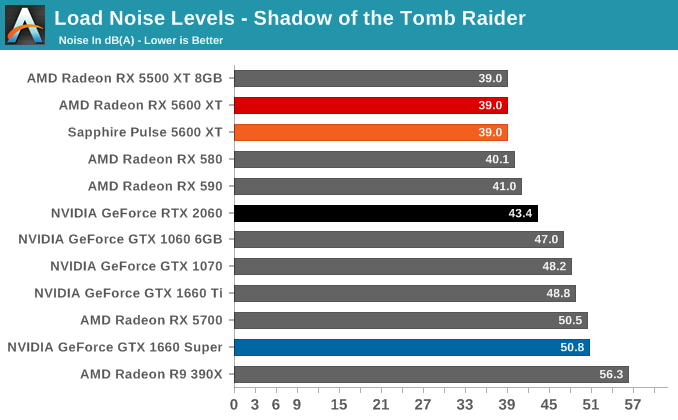

Finally, with noise, we get a chance to see how quietly the oversized Pulse can operate. And the answer is “very quietly”. At idle the card is entirely silent, thanks to its zero fan speed idle mode. Meanwhile with the quiet mode BIOS clocked at AMD’s reference clockspeeds, the fans only have to go to the card’s bare minimum fan speed – 25 percent – to keep the card cool, even under FurMark. To put this in context, we’re looking at a 150W card that’s having all of its cooling needs being met by a pair of fans running at a mere 750 RPM, which is a fraction of what they can actually run at.
Even with the factory overclock active, the cooler has no problem keeping up. Load noise for the 180W mode peaks at 41.2dB(A), which is close to silent and a great result overall. So for as much ribbing as I give Sapphire for the somewhat absurd size of the card, there’s no arguing with the effectiveness of the cooler. It’s quieter than almost every other card in this chart, including the GeForce GTX 1660 series cards and NVIDIA’s own reference RTX 2060.










202 Comments
View All Comments
Korguz - Wednesday, January 22, 2020 - link
TheinsanegamerN but the everage user.. wont overclock.. so thats not really valid....haukionkannel - Thursday, January 23, 2020 - link
There Are test where there Are OC 5600xt and OC 2060 And They were quite near each others!For example Hardware Unboxing did use OC msi cards from both gpu manufacturers.
Spunjji - Wednesday, January 22, 2020 - link
I'm guessing the answer most would give is "because RTX", even though that doesn't become a remotely sensible answer until the 2070 Super.Marketing - it works.
V1tru - Wednesday, January 22, 2020 - link
I would invest the 20 bucks for Raytracing.Same story with my choise, I spent 80 bucks more to get 2070S over 5700 XT for Raytracing and better cooling, so competition here look like balanced
supdawgwtfd - Wednesday, January 22, 2020 - link
Raytracing on a 2060 is pointless.It doesn't have enough grunt.
It should be ignored as a feature as it cannot be used without giving up a lot of other arguably more important things (FPS, resolution etc).
MASSAMKULABOX - Monday, January 27, 2020 - link
Yes 2060 ray tracing is all but useless .. altho the 2060 w/o RT is faster than the 1660ti. The 2060KO uses a 2080 chip with some features cut out so is not a directKorguz - Tuesday, January 28, 2020 - link
you have a link for this.. i cant seem to find anything on it.. so either its evga just naming the card that, or its as you say...sonny73n - Thursday, January 23, 2020 - link
So you’re comparing vanilla to overclocked. Irrelevant. Next!schujj07 - Thursday, January 23, 2020 - link
OC in name only. AMD must have figured that nVidia would drop the price of the 2060 otherwise they wouldn't have had the vBIOS available right after the price drop announcement. My assumption is further confirmed by the chip coming with 14Gbps RAM that had been down clocked to 12Gbps with the original BIOS. Had they not planned on releasing the vBIOS getting 12Gbps RAM instead of 14Gbps would have reduced the cost of the card.flyingpants265 - Thursday, January 23, 2020 - link
Because $20 is not a large difference at all? And 2060 belongs to a much larger, more reliable brand?